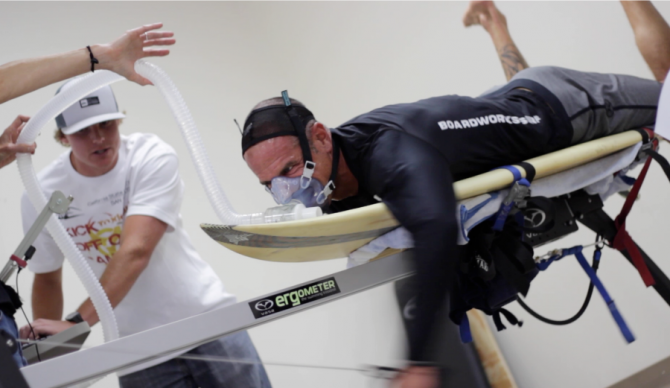
Surf science in progress at Cal State San Marcos. Photo: Cal State University San Marcos
Surfers are notoriously unscientific. Just ask someone how big the surf is. We’re worse than fishermen when it comes to determining size. That’s why it’s refreshing to know that there’s a pair of scientists looking into a bunch of aspects of our sport that apply to everyday surfers.
That would be Jeff Nessler and Sean Newcomer, two professors-slash-surfers at Cal State University San Marcos. They’ve put their curiosity about surfing, not to mention an army of students and some high-priced equipment, to work over the past year or so.
Take the standard surf industry method of testing a wetsuit: Hand it to a pro surfer or a buddy and see what they think. “This is not a good way of evaluating products. That’s anecdotally driven and there’s a high likelihood biases will play into it,” Newcomer says.
Unlike traditional sports, surfing hasn’t benefitted from decades of study. “All that scientific inquiry has moved performance and enjoyability in those sports to higher levels,” he says. “Hopefully our information will lead to a greater ability to manufacture products that will lead to that.”
Ditto for skateboarding and other action sports they want to study, too. “I’d like to see a mind-shift toward looking at those sports more as forms of exercise and worthy of study,” Nessler says. The duo are also optimistic that the spread of wavepools — a controlled environment that eliminates many variables present in the ocean — will take surf science to the next level.
To save you from looking at a bunch of eye-crossing graphs, we’ve collected the most interesting and useful conclusions from their experiments.
Finding #1: Wearing a Wetsuit Doesn’t Make Paddling Harder (At Least Not In a Lab)
Contrary to what you might think, wearing a wetsuit doesn’t make paddling any harder. At least not for study subjects in a lab who aren’t in water. For this one, participants laid down on a surfboard while hooked up to an ergometer, which measured their movements, and other sensors that detected their oxygen use and muscle activation. Are you wondering how actually being in the ocean might change that? So are Nessler and Newcomer, and they’re going to try to improve upon this research.
This study had another finding that’s kind of weird: Wearing a wetsuit top changed the arc of the paddle stroke. Why is unclear. But it could mean that wetsuits puts the wearer at lower risk of overuse injury because the wear and tear is dispersed.
Finding #2: Wetsuit Designs Are All Wrong.
Here’s why: In one study, Nessler and Newcomer hooked up a bunch of heat sensors to study subjects wearing 3-millimeter suits during a surf in the ocean. By the end of the sesh, they found differences of as much as 50 degrees Fahrenheit between various body parts, the upper arms and chest being warmer than the lower body. Could you stand to lose a lot of rubber from the shoulder area and gain some around the legs? “You’d think every wetsuit company has done this study, but no one has,” Newcomer says. Here’s a possible solution: Neoprene panels whose thickness tapers from one end to the other.
Finding #3: Rash Guards Keep You Cool.
In the name of science, these guys went surfing in Costa Rica. Along with our jealousy, they came home with this tidbit: In addition to warding off nipple rash and being torched by the sun, rash guards keep you cooler than wearing no shirt at all. If you’ve surfed in 85-degree tropical waters, you know that overheating can be a problem. “You don’t realize it, but you’re sweating in those regions,” Newcomer says.
A couple of other take-aways that science has now verified:
– Higher board volume really does make it easier to paddle a surfboard.
– Surfing meets federal guidelines for high school physical education.
– Surfers who are getting on in years actually have surf sessions similar to younger surfers, meaning they surf as many waves and spend the same amount of time paddling. This is probably due to being smarter about how they go about it despite being in worse shape. Older surfers are probably better at positioning themselves, plus they tend to use bigger boards and surf at times and places (think dawn patrol) when lineups are less crowded.

